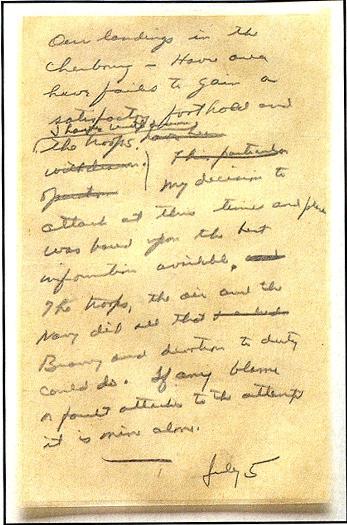LESSON PLAN:
Eisenhower Speaks: Analyzing D-Day Orders
Primary sources can be documents, pictures, or artifacts that were produced during a certain time. Instead of merely reading second-hand descriptions (secondary sources) of an event, a thorough historian will also want to look at writing from that particular period. Examining letters and other writing is especially helpful when studying historical figures. In this lesson, you will learn a lot about General Eisenhower’s style, motivation, and leadership ability by studying his writings.
Objective:
By reading two documents that General Dwight Eisenhower wrote before D-Day and answering questions about them, students will learn about the general’s style, motivation, and leadership ability. After answering the questions, students will be able to write their own Order of the Day—message of inspiration.
Grade Level: 7-12
Standards:
History Thinking Standard 2— the student comprehends a variety of historical sources and can reconstruct the literal meaning of a historical passage and identify its central message.
Content Era 8 (1929-1945), Standard 3B—the student understands World War II and how the Allies prevailed.
Time Requirement: One class period for discussion and worksheet completion. Additional time for essay as needed (in class or as homework).
Download a printable pdf version of this lesson plan
Directions:
1. Pass out copies of the two writings by Eisenhower to students to read on their own or have students read them aloud. A Fact Sheet is included if students need an overview of D-Day. This may be read aloud by the teacher or given to students to read on their own.
2. Pass out worksheet questions for students to complete.
3. Hold a short discussion about the way Eisenhower uses language to motivate his men in his Order of the Day. State specific examples. What can we learn about Eisenhower’s personality and style from his hand-written note? What does it tell us about his motivation? His leadership ability? Discuss the use of documents as a primary source of historical information. Explore the pros and cons of using such sources.
4. Assign students the task of writing an Order of the Day for students at their school. The style of the Order should be motivational, while the content can be anything from an upcoming football game or standardized test, to a call for school pride through less littering, recycling, etc.
5. Students may volunteer to read their Orders to the class.
Assessment:
Components for assessment include the worksheet and the student-written Orders.
Documents
Eisenhower’s Order of the Day
Every American soldier, sailor, and airman participating in the D-Day invasion of Normandy received this message of inspiration from Supreme Commander, General Dwight Eisenhower, just before D-Day.

Eisenhower’s D-Day Failure Message
General Eisenhower wrote this message just prior to the invasion, to be read in case Operation Overlord failed. Either through stress or fatigue he misdated it July 5, instead of June 5.
“Our landings in the Cherbourg-Havre area have failed to gain a satisfactory foothold and I have withdrawn the troops. My decision to attack at this time and place was based upon the best information available. The troops, the air and the Navy did all that bravery and devotion to duty could do. If any blame or fault attaches to the attempt it is mine alone.”
--Eisenhower Library and Museum

Questions to Discuss
After reading the two D-Day documents from General Dwight Eisenhower and their descriptions, answer the questions below. Indicate where you find your answers. If you use quotes, be sure to put quotation marks around them.
Directions: Answer the following questions about the two depictions of Rosie the Riveter.
1. Who is Eisenhower addressing in his Order of the Day?
2. What words and phrases does Eisenhower use to convey the idea of teamwork?
3. If he is trying to motivate the troops, why does he say, “Your task will not be an easy one”?
4. What is the importance of honesty in communication?
5. What historical information about WWII can you learn from studying this document?
6. After reading Eisenhower’s D-Day failure message, describe his concept of taking responsibility.
7. Why do you think Eisenhower gives so little information about the attempted invasion?
8. What historical information about D-Day can you learn from studying this document?
9. Describe Eisenhower’s personality based solely on these two documents.
10. What other primary sources of information would you want to have to create a fuller description of Eisenhower?
Download a printable pdf version of this lesson plan
TAKE ACTION:


EDUCATION PROJECTS:
Student Travel – WWII Educational Tours
High school and college students, learn the leadership principles that helped win WWII on a trip to France or during a weeklong residential program in New Orleans. College credit is available, and space is limited.
See You Next Year! HS Yearbooks from WWII
Collected from across the United States, the words and pictures of these yearbooks present a new opportunity to experience the many challenges, setbacks and triumphs of the war through the eyes of America’s youth.
The Victory Gardens of WWII
Visit the Classroom Victory Garden Project website to learn about food production during WWII, find lesson plans and activities for elementary students, get tips for starting your own garden and try out simple Victory Garden recipes!
The Science and Technology of WWII
Visit our new interactive website to learn about wartime technical and scientific advances that forever changed our world. Incorporates STEM principles to use in the classroom.
Kids Corner: Fun and Games!
Make your own propaganda posters, test your memory, solve puzzles and more! Learn about World War II and have fun at the same time.



